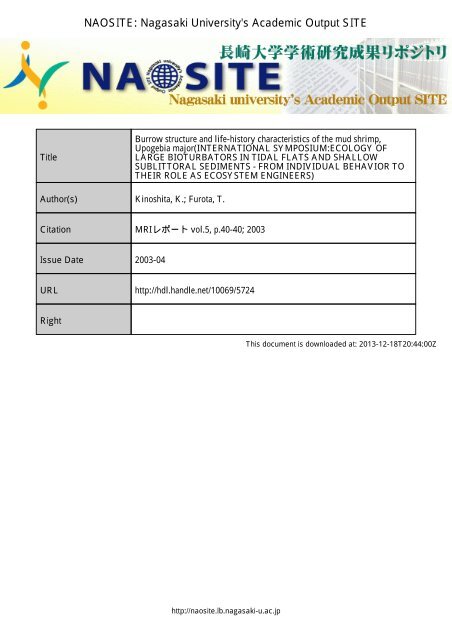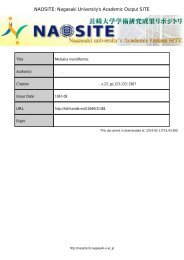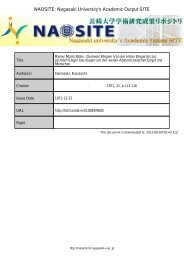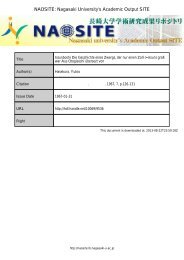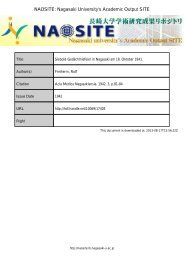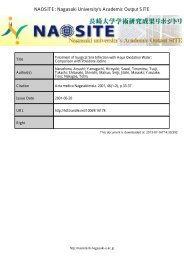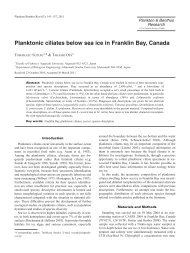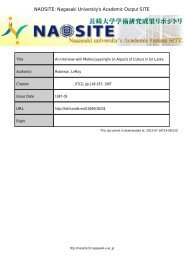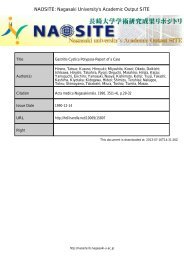Burrow structure and life-history characteristics of the mud shrimp ...
Burrow structure and life-history characteristics of the mud shrimp ...
Burrow structure and life-history characteristics of the mud shrimp ...
You also want an ePaper? Increase the reach of your titles
YUMPU automatically turns print PDFs into web optimized ePapers that Google loves.
NAOSITE: Nagasaki University's Ac<br />
Title<br />
<strong>Burrow</strong> <strong>structure</strong> <strong>and</strong> <strong>life</strong>-<strong>history</strong> c<br />
Upogebia major(INTERNATIONAL SYMPOS<br />
LARGE BIOTURBATORS IN TIDAL FLATS A<br />
SUBLITTORAL SEDIMENTS - FROM INDIVI<br />
THEIR ROLE AS ECOSYSTEM ENGINEERS)<br />
Author(s) Kinoshita, K.; Furota, T.<br />
Citation MRIレポート vol.5, p.40-40; 2003<br />
Issue Date 2003-04<br />
URL<br />
http://hdl.h<strong>and</strong>le.net/10069/5724<br />
Right<br />
This document is downloaded<br />
http://naosite.lb.nagasaki-u.ac.jp
Kinoshita, K. <strong>and</strong> T. Furota<br />
Department <strong>of</strong> Biology, Faculty <strong>of</strong> Science, Toho University, Miyama 2-2-1,<br />
Funabashi-shi, Chiba 274-8510, JAPAN<br />
<strong>Burrow</strong> <strong>structure</strong> <strong>and</strong> <strong>life</strong>-<strong>history</strong> <strong>characteristics</strong> <strong>of</strong> <strong>the</strong> <strong>mud</strong> <strong>shrimp</strong>, Upogebia<br />
major<br />
The <strong>mud</strong> <strong>shrimp</strong> Upogebia major is a common species on <strong>mud</strong>dy tidal flats in Japan. In<br />
this presentation, we report <strong>the</strong> burrow <strong>structure</strong> <strong>and</strong> <strong>life</strong>-<strong>history</strong> <strong>of</strong> <strong>the</strong> <strong>mud</strong> <strong>shrimp</strong> <strong>of</strong><br />
Tokyo Bay. The burrow was Y-shaped <strong>and</strong> <strong>the</strong> depth exceeded 2 m below <strong>the</strong> sediment<br />
surface. Mud <strong>shrimp</strong> burrows provide habitat for small organisms such as phoronid<br />
worm. Pelagic larvae <strong>of</strong><strong>the</strong> <strong>mud</strong> <strong>shrimp</strong> started to hatch in late winter <strong>and</strong> settled in mid<br />
spring. Females deposited <strong>the</strong>ir first eggs in <strong>the</strong> third winter, <strong>the</strong>y lived for at least<br />
several years. The deep burrows provide refuge from predators <strong>and</strong> physical stress,<br />
allowing <strong>the</strong> <strong>shrimp</strong>s to survive for a long time. The <strong>mud</strong> <strong>shrimp</strong> supplies oxygen-rich<br />
water to <strong>the</strong>ir deep burrow, <strong>and</strong> exerts a large influence on <strong>the</strong> <strong>structure</strong> <strong>and</strong> metabolism<br />
<strong>of</strong><strong>the</strong> tidal flat benthic community.<br />
- 40-


